CMSC 635 Spring 1999 - Anti-Aliasing

CMSC 635: Advanced Computer Graphics
Introduction to Aliasing and Anti-Aliasing
Techniques
Spring 1999
David S. Ebert
Computer Science and Electrical Engineering Department
University of Maryland, Baltimore County
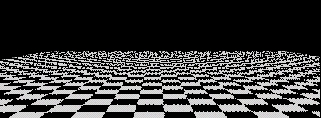
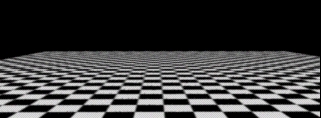
Why does Aliasing Occur?
Discretely sampling a continuous
signal/function/object.
Two components: Sampling and re-construction
Where does Aliasing Occur?
Motion - popping/flashing/strobing
Edges - jaggies
Textures - crawling/ Moire patterns
Missing details in textures, geometry
An Illustrated Example: A
Spinning Cylinders
Example animation
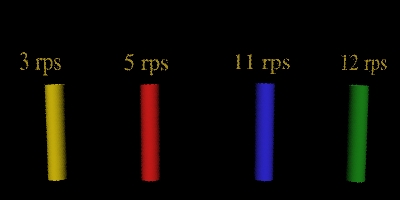
Spinning cylinders starting position.
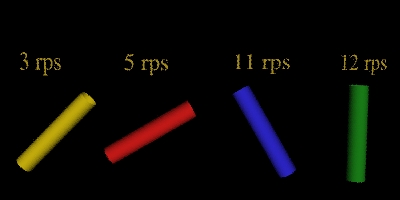
Spinning cylinders after 1/24 second.
What is going on?
| Rotation Rate | 0/24 second | 1/24 second |
2/24 second |
| 3 rps | 0 deg. | 45 deg. | 90 deg.
|
| 5 rps | 0 deg. | 75 deg. | 150
deg.
|
| 11 rps | 0 deg. | 165 deg. |
330 deg.
|
| 12 rps | 0 deg. | 180 deg. |
360 deg.
|
Sampling:
How frequently should we sample?
- Too much -- waste of time
- Need to sample the signal frequently enough to be able to
reconstruct it correctly.
- Too little (undersampling) -- lose information --> aliasing
- Undersampling can cause the signal to appear as a lower frequency
signal - it aliases
Need to sample the signal at least at twice it's frequency
(Nyquist Criteria)
Example of 1D aliased sampling:
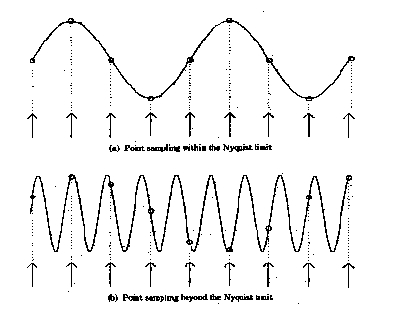
Sampling Theory
-
- Shannon's Sampling Theorem:
- A continuous bandlimited function of a single variable
can be completely represented by a set of samples made at
equally spread intervals. The interval between samples
must be less than half the period (or greater than twice
the frequency) of the highest frequency components in the
spectrum (called the Nyquist Limit).
- Brief overview of Fourier Synthesis
Any signal can be represented as a series of sine waves of
different frequencies.
Fourier transformation pair:


F(u) is the sum of sine waves because

u = frequency of sine wave -- frequency domain
x -- spatial domain
- Convolution

if I(x) -> F(u) and g(x) -> G(u)
I(x) * g(x) -> F(u)G(u) (convolve in spatial, multiply in frequency
domain)
I(x)g(x) -> F(u) * G(u) (multiply in spatial, convolve in frequency domain)
So, to create frequency representation of the function, multiply by
reconstruction filter ==> original frequency function of the signal.
No information lost iff

or

where x is sampling rate and  is the Nyquist Limit.
is the Nyquist Limit.
- Aliasing occurs when
- Common Aliasing Solution:
Super-sampling: sample x times / pixel
Reconstruction/Filtering:
- How do you combine the samples to get the
original signal back?
- Equal weights (square filter)
- Center weighted (pyramid)
- Gaussian
- Example
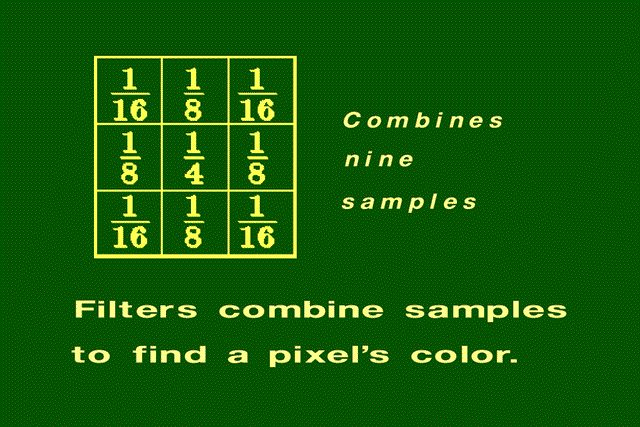
- Pre-filtering
- Consider pixel as area and integrated contribution to that pixel
- Post-filtering
- Sample the pixel and then reconstruct the samples (filter) to get
pixel value
- Ordered sampling/regular sampling - use pre-defined grid
- Stochastic sampling - sample randomly
- Jittered sampling (Cook) - stochastically jitter the regular sampling
grid
- Human eye finds noise less objectionable/noticable
- => trade noise
for aliasing artifacts
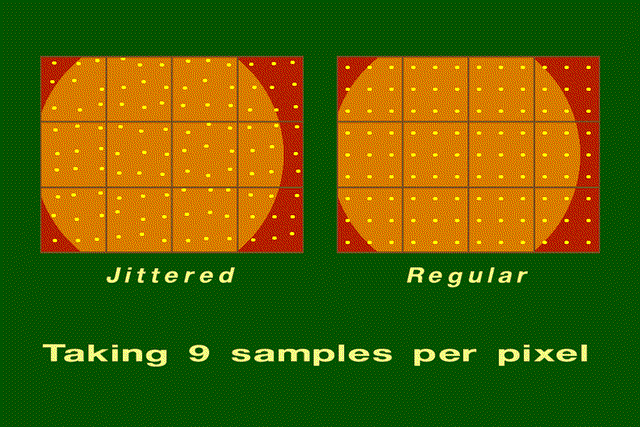
- Examples:
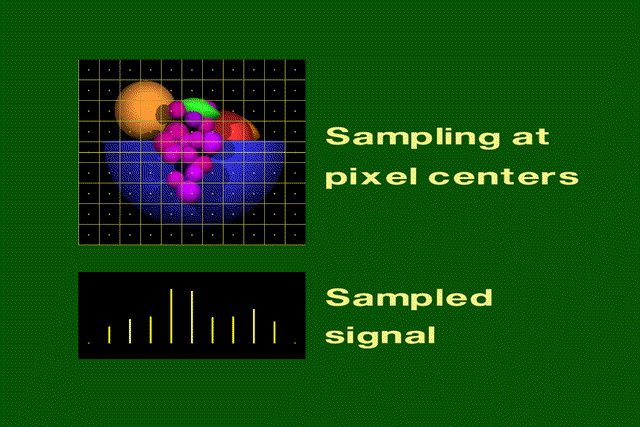
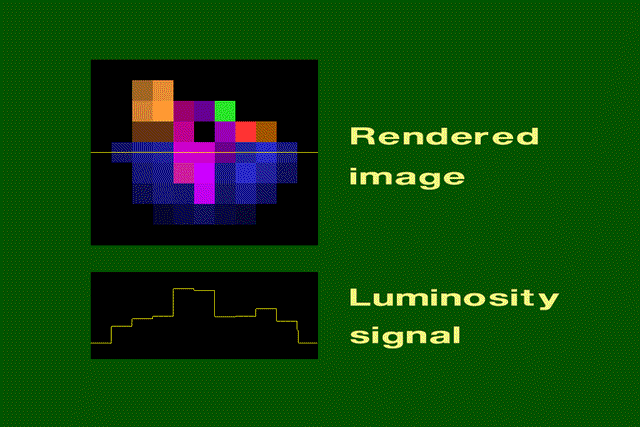
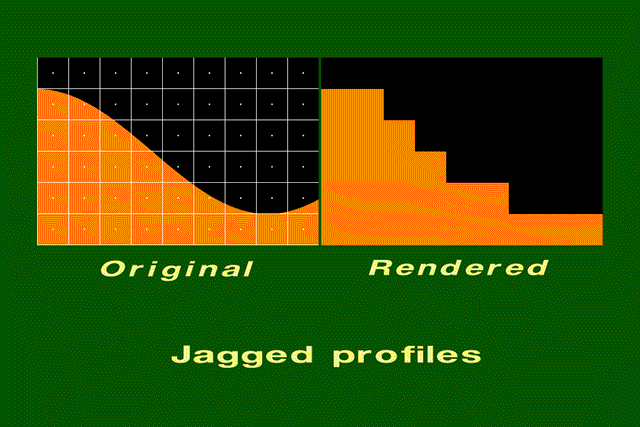
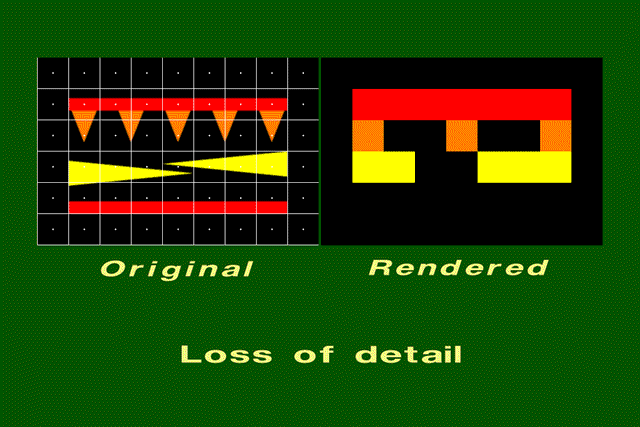
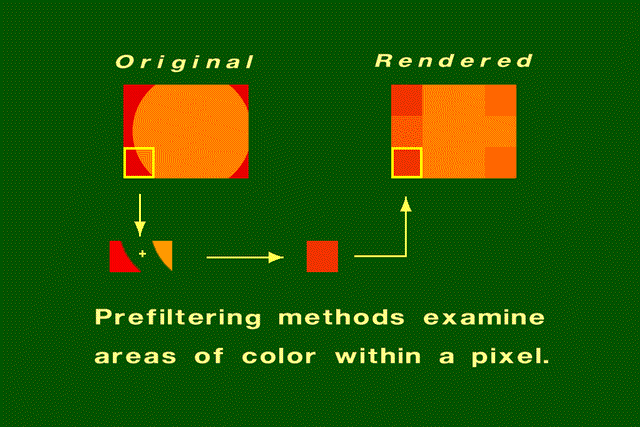
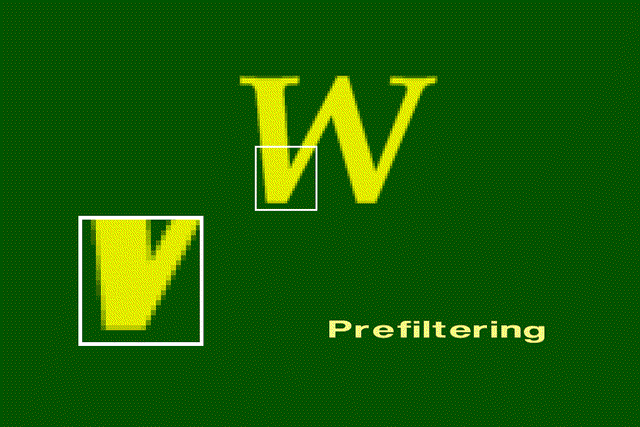
Example Controls in a Commercial
Package: Maya
- Anti-aliasing
- low-quality - 2 samples per pixel
- med-quality - 8 samples per pixel
- high-quality - 32 samples per pixel
- highest-quality - 32 samples per pixel in pass 1, look for high
contrast areas and resample them to get better resolution
- Texture Maps
- Mip-map - store at various levels of detail (pre-filtered texture
maps)
- Others - filters from simplest to most accurate
- Shading anti-aliasing
- Multi-pixel filter - Looks at 3x3 pixels and filters them
- Shading samples - number of samples for each pixel fragment
-
for shading computations
- Max shading samples - for 2nd pass of Highest quality
- Particle samples - same as shading samples
- Motion blur - number of time samples made
- Procedural Texture aliasing
- choose filter size
- control number of iterations and frequencies you allow into it.
Antialiased texture mapping
- Covered before (see Texture mapping notes)
Return to CMSC 635 Notes Page













